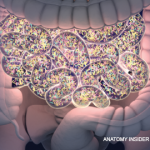
Recent data suggest that our commensal microbiota are not passive, but reflect and even induce systemic disease.
T. L. Furrer/shutterstock.com
The microbiome comprises diverse microbial flora, including bacteria, viruses and fungi, that live on mucosal surfaces, predominantly the skin and digestive tract. Microbes evolved billions of years prior to the development of modern Homo sapiens 200,000 years ago; we have always existed with their ubiquitous presence. Despite this, the first microbe was not visualized until 1665 when Robert Hooke and Antoni van Leeuwenhoek published a drawing of Mucor.1 Alexander Fleming’s discovery of penicillin in 1928 not only revolutionized modern medicine, but also established the understanding of bacteria as single agents primarily antagonistic to human health. Microbial research focused on attacking and eliminating bacteria and viruses, with little regard for the commensal flora that live inside of us.
These residents were thought to remain relatively static, existing independently of host health or disease. Recent data suggest that our commensal microbiota are not passive, but reflect and even induce systemic disease. Advances in technology and bioinformatics over the past decade have stimulated this expanding field, allowing for more comprehensive analysis of this complex ecosystem, and now not only encompass the microbiome, but also the proteome and metabolome, the proteins and metabolites these flora produce. Most research has focused on bacterial flora, but there are increasing studies investigating the virome and fungome. Growing data suggest that alterations in this flora, termed dysbiosis, play a large role in the development of rheumatic diseases.
Rheumatoid Arthritis (RA)
RA has a concordance of 15.4% in monozygotic twins, strongly suggesting a significant environmental role in disease pathogenesis.2 There has been long-standing suspicion that RA is secondary to infection. A review article in 1931 noted that the popular term for RA at the time was chronic infectious arthritis and the underlying etiology of an infection was the most accepted hypothesis for disease pathogenesis.3 For more than 65 years, treatment of RA has utilized antimicrobials; sulfasalazine contains sulfapyridine, an antibiotic, and randomized trials have shown minocycline and macrolides are effective at decreasing disease activity.4
However, data demonstrating a microbial role in RA pathogenesis remain indirect. Examination of fecal, salivary and dental microbiomes of patients with established RA demonstrates that dysbiosis in the oral and gastrointestinal tract correlates with reduced disease activity and resolves with treatment.5 The association between periodontal disease caused by Porphyromonas gingivalis and patients with RA who have antibodies to citrullinated proteins (ACPA) proposes that mucosal inflammation caused by P. gingivalis can lead to the generation of ACPA and subsequently RA.6-8
Similarly, ACPA of the IgA isotype have been found in the sputum of seronegative individuals at risk for developing RA, supporting a mucosal origin of ACPA, which may be influenced by resident microbiota.9 In the intestine, Prevotella copri is expanded in the feces of newly diagnosed, untreated patients with RA, compared with those with established disease and healthy controls.10
In spite of the strong correlative data between disease and microbiome changes, identifying a causative role for the microbiome to stimulate immune changes that lead to RA remains elusive. The mechanism in which microbial changes influence disease is still unclear, and hypotheses include molecular mimicry, creation of an inflammatory environment that changes immune function, moderating nutrient absorption or modifying proteins secreted by human cells.
Future studies will need to aim at identifying bacterial interactions with host mucosa and downstream immune alterations leading to disease development to provide a causal link between dysbiosis and RA.
Spondyloarthritis (SpA)
The idea that changes in gut homeostasis influence the development of seronegative arthritis, termed gut–joint hypothesis, also has notable indirect evidence. About 32% of individuals with inflammatory bowel disease (IBD), a condition with well-established intestinal dysbiosis, have radiographic evidence of axial arthritis, and 18–45% will develop symptoms related to joint inflammation.11,12 Reactive arthritis (ReA), which can be caused by gastrointestinal infections with gram-negative bacteria, provides more clinical evidence of the gut–joint hypothesis. Fragments of the ReA-associated organisms that originate in the colon, Yersinia and Salmonella, have been found in the synovium of patients with ReA.13 Cell culture studies have demonstrated that HLA-B27 cells are more readily infected with Salmonella, and gut-derived monocytes and T cells can be found within the joints of those with SpA.14-17 Consequently, microbe–host interactions in the intestine appear connected to joint pathophysiology.
Microbiome studies of individuals with psoriasis find reduced cutaneous bacterial diversity and partial normalization after treatment with systemic therapies.18 However, preliminary data presented as an abstract at the 2015 ACR/ARHP Annual Meeting suggest that there are no differences between the skin microbiome of individuals with psoriasis and those with psoriatic arthritis, suggesting that the dysbiotic populations driving arthritis are unlikely to be cutaneous.19
In the intestine, patients with either psoriasis or psoriatic arthritis both have decreased fecal Coprococcus compared with healthy controls, but individuals with psoriatic arthritis also have increases in certain bacterial taxa that were not observed with psoriasis alone.20 Unfortunately, the specific effect of Coprococcus on host physiology is unknown, but it’s likely mediated through the production of short-chain fatty acids, some of which are known immune regulators.21,22
In the 1970s two reports suggested that colonic Klebsiella pneumoniae is associated with ankylosing spondylitis (AS).23,24 More recently, microbiome studies of individuals with established AS have shown decreased sulfate-reducing bacteria in the colon.25 In the small intestine, there is an increased abundance of several taxa that are also augmented in Crohn’s disease, in concordance with the overlap of clinical manifestations between AS and Crohn’s disease.26
To date, the microbiome of AS has focused on established disease of approximately 10 years, but a small study of children with enthesitis-related arthritis demonstrated dysbiosis in all subjects with two distinct microbial patterns: One predominantly male cluster had a relatively high abundance of Bacteroides genus, and the second predominantly female cluster had a relatively high abundance of Akkermansia muciniphila.27 Whether these patterns reflect sex differences, prognosis or future clinical manifestations has yet to be determined.
Future Directions
Although many gaps exist in our knowledge of how the microbiome interacts with mucosal surfaces and, ultimately, shapes the immune system, this field is rapidly emerging within rheumatology. Studies of the bacterial, viral, and fungal microbiomes are underway in many diseases, and already have limited, but promising, results in systemic lupus erythematosus, Sjögren’s syndrome and Behçet’s.28-30
Our understanding of the microbiome as a causal mediator between health and disease is limited. Fecal transplant, the process in which intestinal flora from healthy individuals is transferred to those with disease, has been well established as an effective treatment of Clostridium difficile.31 A randomized placebo-controlled trial of fecal transplant in IBD showed mixed efficacy, with no change in quality of life or disease activity.32
Intriguingly, transplants from certain donors, termed superdonors, seemed to give significantly better outcomes. The study suggests that there are nuances to even healthy microbiome populations, and a much better understanding of the microbiome’s effect on the host is required before proceeding with therapies aimed at correcting dysbiosis.
Larger scale and longitudinal data also are currently lacking. The American Gut Project is collecting mail-in microbiome samples from various mucosal sites from anyone who applies online, including pets; they have amassed more than 3,000 samples.33 The NIH Human Microbiome project has initiated three longitudinal studies that focus on pregnancy, IBD and the onset of type 2 diabetes with multiple samples collected from the same individuals over more than three years.34 Currently, data are from patients with established disease; it remains unclear if dysbiosis drives autoimmunity or merely reflects the presence of existing inflammation. For rheumatologic diseases, we propose identifying high-risk individuals, as has been done with RA, and follow them long term, collecting multiple samples—for microbiome and immunologic assays—over time, even after disease is established and therapy initiated. In this manner, we can begin to understand the relationship between the microbiome, immune function and rheumatologic disease.
Summary
In 1683, Leeuwenhoek wrote a letter to the Royal Society of the Arts describing what he had seen when he looked at his own dental plaque under a microscope. He described “animalcules … were in such enormous numbers [and] seemed to be alive.”35 The first bacteria observed and described was our own microbiome. Even on initial observation, it was a dynamic and vibrant community. Emerging research suggests that shifts in our microbial flora may contribute or increase susceptibility to rheumatic diseases. Longitudinal and causal data are currently lacking but, with additional study, are promising and may point to novel methods of diagnoses or therapies.
Neha Ohri, MD, is a third-year rheumatology fellow at the University of Colorado School of Medicine, Aurora, Colo.
Kristine Kuhn, MD, PhD, is an assistant professor of medicine in the Division of Rheumatology at the University of Colorado School of Medicine. Her research focuses upon the interactions of the microbiome and mucosa on the development of systemic autoimmunity.
References
- Gest H. The discovery of microorganisms by Robert Hooke and Antoni Van Leeuwenhoek, fellows of the Royal Society. Notes Rec R Soc Lond. 2004;58(2):187–201.
- Silman AJ, MacGregor AJ, Thomson W, et al. Twin concordance rates for rheumatoid arthritis: Results from a nationwide study. Br J Rheumatol. 1993;32(10):903–907.
- Cecil RL, Nicholls EE, Stainsby WJ. The etiology of rheumatoid arthritis. Am J Med Sci. 1931;181(1):12–24.
- Ogrendik M. Antibiotics for the treatment of rheumatoid arthritis. Int J Gen Med. 2013 Dec 27;7:43–47. doi:10.2147/IJGM.S56957.
- Zhang X, Zhang D, Jia H, et al. The oral and gut microbiomes are perturbed in rheumatoid arthritis and partly normalized after treatment. Nat Med. 2015 Aug;21(8):895–905. doi:10.1038/nm.3914.
- Mikuls TR, Thiele GM, Deane KD, et al. Porphyromonas gingivalis and disease-related autoantibodies in individuals at increased risk of rheumatoid arthritis. Arthritis Rheum. 2012 Nov;64(11):3522–3530. doi:10.1002/art.34595.
- Bello-Gualtero JM, Lafaurie GI, Hoyos LX, et al. Periodontal disease in individuals with a genetic risk of developing arthritis or with early rheumatoid arthritis: A cross-sectional study. J Periodontol. 2015 Nov 26;1–18. doi:10.1902/jop.2015.150455.
- Terao C, Asai K, Hashimoto M, et al. Significant association of periodontal disease with anti-citrullinated peptide antibody in a Japanese healthy population—The Nagahama study. J Autoimmun. 2015 May;59:85–90. doi:10.1016/j.jaut.2015.03.002.
- Willis VC, Demoruelle MK, Derber LA, et al. Sputum autoantibodies in patients with established rheumatoid arthritis and subjects at risk of future clinically apparent disease. Arthritis Rheum. 2013 Oct;65(10):2545–2554. doi:10.1002/art.38066.
- Scher JU, Sczesnak A, Longman RS, et al. Expansion of intestinal Prevotella copri correlates with enhanced susceptibility to arthritis. Elife. 2013 Nov 5;2:e01202. doi:10.7554/eLife.01202.
- Walters WA, Xu Z, Knight R. Meta-analyses of human gut microbes associated with obesity and IBD. FEBS Lett. 2014 Nov 17;588(22):4223–4233. doi:10.1016/j.febslet.2014.09.039.
- Arvikar SL, Fisher MC. Inflammatory bowel disease associated arthropathy. Curr Rev Musculoskelet Med. 2011 Sep;4(3):123–131. doi:10.1007/s12178-011-9085-8.
- Kuhn KA, Pedraza I, Demoruelle MK. Mucosal immune responses to microbiota in the development of autoimmune disease. Rheum Dis Clin North Am. 2014 Nov;40(4):711–725. doi:10.1016/j.rdc.2014.07.013.
- Ge S, He Q, Granfors K. HLA-B27 modulates intracellular growth of Salmonella pathogenicity island 2 mutants and production of cytokines in infected monocytic U937 cells. PLoS One. 2012;7(3):e34093. doi:10.1371/journal.pone.0034093.
- Laitio P, Virtala M, Salmi M, et al. HLA-B27 modulates intracellular survival of Salmonella enteritidis in human monocytic cells. Eur J Immunol. 1997 Jun;27(6):1331–1338.
- Penttinen MA, Heiskanen KM, Mohapatra R, et al. Enhanced intracellular replication of Salmonella enteritidis in HLA-B27-expressing human monocytic cells: Dependency on glutamic acid at position 45 in the B pocket of HLA-B27. Arthritis Rheum. 2004 Jul;50(7):2255–2263. doi:10.1002/art.20336.
- Jacques P, Elewaut D. Joint expedition: Linking gut inflammation to arthritis. Mucosal Immunol. 2008 Sep;1(5):364–371. doi:10.1038/mi.2008.24.
- Alekseyenko AV, Perez-Perez GI, De Souza A, et al. Community differentiation of the cutaneous microbiota in psoriasis. Microbiome. 2013 Dec 23;1(1):31. doi:10.1186/2049-2618-1-31.
- Castelino M, Eyre S, Tutino M, et al. Bacterial skin microbiome in psoriatic arthritis—Pilot data from psoriatic plaques on dry skin sites from patients with psoriasis (PsC) and psoriatic arthritis (PsA). 2015 ACR/ARHP Annual Meeting. Abstract Number: 2806. 2015 Sep 29.
- Scher JU, Ubeda C, Artacho A, et al. Decreased bacterial diversity characterizes the altered gut microbiota in patients with psoriatic arthritis, resembling dysbiosis in inflammatory bowel disease. Arthritis Rheumatol. 2015 Jan;67(1):128–139. doi:10.1002/art.38892.
- Duncan SH, Barcenilla A, Stewart CS, et al. Acetate utilization and butyryl coenzyme A (CoA): Acetate-CoA transferase in butyrate-producing bacteria from the human large intestine. Appl Environ Microbiol. 2002 Oct;68(10):5186–5190. doi:10.1128/AEM.68.10.51865190.2002.
- Vinolo MAR, Rodrigues HG, Nachbar RT, Curi R. Regulation of inflammation by short chain fatty acids. Nutrients. 2011 Oct;3(10):858–876. doi:10.3390/nu3100858.
- Ebringer R, Cawdell D, Ebringer A. Klebsiella pneumoniae and acute anterior uveitis in ankylosing spondylitis. Br Med J. 1979 Feb 10;1(6160):383.
- Ebringer RW, Cawdell DR, Cowling P, Ebringer A. Sequential studies in ankylosing spondylitis. Association of Klebsiella pneumoniae with active disease. Ann Rheum Dis. 1978 Apr;37(2):146–151.
- Stebbings S. Comparison of the faecal microflora of patients with ankylosing spondylitis and controls using molecular methods of analysis. Rheumatology (Oxford). 2002 Dec;41(12):1395–1401.
- Costello M-E, Ciccia F, Willner D, et al. Intestinal dysbiosis in ankylosing spondylitis. Arthritis Rheumatol. 2014 Nov 21. doi:10.1002/art.38967.
- Stoll ML, Kumar R, Morrow CD, et al. Altered microbiota associated with abnormal humoral immune responses to commensal organisms in enthesitis-related arthritis. Arthritis Res Ther. 2014 Nov 30;16(6):486. doi:10.1186/s13075-014-0486-0.
- Hevia A, Milani C, López P, et al. Intestinal dysbiosis associated with systemic lupus erythematosus. MBio. 2014 Sep 30;5(5):e01548–01514. doi:10.1128/mBio.01548-14.
- Sandhya P, Sharma D, Vellarikkal SK, et al. AB0188 systematic analysis of the oral microbiome in primary Sjögren’s syndrome suggest enrichment of distinct microbes. Ann Rheum Dis. 2015 May;74(Suppl 2):953.3–954.
- Consolandi C, Turroni S, Emmi G, et al. Behçet’s syndrome patients exhibit specific microbiome signature. Autoimmun Rev. 2015 Apr;14(4):269–276.
- Brandt LJ, Aroniadis OC, Mellow M, et al. Long-term follow-up of colonoscopic fecal microbiota transplant for recurrent clostridium difficile infection. Am J Gastroenterol. 2012 Jul;107(7):1079–1087. doi:10.1038/ajg.2012.60.
- Rossen NG, MacDonald JK, de Vries EM, et al. Fecal microbiota transplantation as novel therapy in gastroenterology: A systematic review. World J Gastroenterol. 2015 May 7;21(17):5359–5371. doi:10.3748/wjg.v21.i17.5359.
- American Gut. What’s in your gut?.
- Consortium TIH (iHMP) RN. The Integrative Human Microbiome Project: Dynamic analysis of microbiome-host omics profiles during periods of human health and disease. Cell Host Microbe. 2014 Sep 10;16(3):276–289. doi:10.1016/j.chom.2014.08.014.
- Alfred R. Sept. 17, 1683: Van Leeuwenhoek gives us reason to brush and floss. Wired. 2008 Sep 17.


